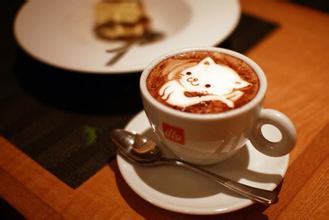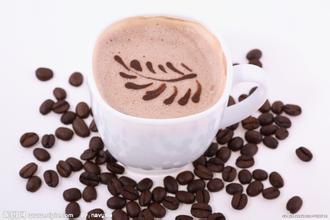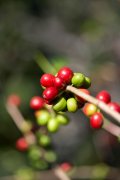Coffee culture in different regions
Italy
Enthusiastic about Italy, there are two things to be careful when visiting Italy: one is a man, and the other is coffee. In Italy, coffee and men are actually two different things, so there is a famous Italian saying: men should be like good coffee, both strong and enthusiastic! Italian coffee, named Espresso in English, has been widely known by coffee lovers in China in recent years. This kind of pure black coffee, which is thick and fragrant, with a layer of golden foam floating on its surface, is thick and hot like the devil escaped from hell. It is often called to drink and falls into unspeakable charm and is unforgettable.
The characteristic of Italian coffee is that it is a fast word in its English name; it can be cooked no more than ten seconds and drank quickly, because there are only two or three mouthfuls. Most Italians make a cup of coffee as soon as they get up. Men and women drink almost from morning till night. A small coffee shop called BAR can be seen everywhere on the street, selling a cup of coffee of about 400 lira, or about NT $10, for people to drink up standing up.
On average, Italians drink 20 cups of coffee a day. Coffee beans mixed with Italian coffee are the most fried beans in the world. This is in line with the special function of the Italian coffee pot to instantly extract coffee. Since the weight of a cup of Italian coffee is only 50cc, and the amount of coffee beans is only six to eight grams, this kind of strong-looking coffee is actually not harmful to the intestines and stomach, and even helps digestion!
There is also a way to drink Italian coffee with milk, called Cappuccino, which uses steam above 130 degrees Celsius in an Italian coffee pot to first foam the milk and then float on the thick black coffee. Sweet fresh milk, pure white lovely; charming Espresso devil under its embellishment, immediately transformed into a wonderful angel!
Viennese like to drink coffee and even compare it with music and waltz, which is called the "three treasures of Vienna". Some people say that Vienna is "five steps and one coffee", which may be an exaggeration by the poet, but it is true that there are a large number of Vienna cafes. From the coffee kiosks around the corner for people to drink standing up, to the coffee shops gathered by students near the university, to the magnificent coffee shops next to the theatre and by the Imperial City, there are at least dozens, some of which open at 06:30 in the morning and do not close until 2 a.m. Therefore, it is not too much to say that the air of the "capital of music" is not only flowing with the rhythm of music, but also filled with the fragrance of coffee.
Drinking coffee has become a part of life in Vienna. In a leisurely atmosphere, people can meet friends in cafes, play chess, read books, write books, read newspapers (usually provide newspapers from many countries), or watch TV in an inconspicuous corner as long as they pay for a cup of coffee. Drinking coffee has become a part of life in Vienna. In a leisurely atmosphere, people can meet friends in cafes, play chess, read books, write books, read newspapers (usually provide newspapers from many countries), or watch TV in an inconspicuous corner as long as they pay for a cup of coffee. Some cafes have their own class of customers-the country, writers or politicians-while most cafes are packed with customers of all kinds. The most famous coffee shop in Vienna is the Central Cafe, which is located in the downtown area. Before World War I, it was a meeting place for famous poets, playwrights, artists, musicians and diplomats. Some people say that this is the cradle of many Austrian poems, plays and novels, which may be an exaggeration, but the music masters Mozart, Beethoven, Schubert, the Waltz Dynasty, Strauss and his son were all regulars here. Today's Central Cafe is doing brisk business, but no matter how crowded it is, guests can stay as long as they want. This is a century-old tradition of the Viennese Cafe. There are also many well-known cafes in Vienna, who always have a close relationship with past or present celebrities. Viennese like to tell visitors which artists and writers often meet in which cafe and which politicians like to meet journalists in which cafe.
There are many kinds of Viennese coffee, from black coffee to various kinds of coffee with milk, each with its own characteristics, suitable for different tastes, and all have their own names. Therefore, walking into the Vienna Cafe, if you simply want a cup of coffee, the waiter will be at a loss, because there are at least 40 varieties of coffee. If you don't know much about coffee and want to experience the unique atmosphere of the Viennese Cafe, order Melange, which is completely Viennese and has a lingering aftertaste. No matter what kind of coffee you want, you will get a cup of water at the same time-for no reason, just because the water in Vienna is so cool and delicious. But if the waiter brings the guest a second glass of water, he will signal, "you have stayed here too long." Viennese love sweets, and they like to order a cup of coffee and add a delicate dessert at the same time.
The cafe's provision of newspapers, pictorials and magazines for readers is one of the major cultural features of the Vienna Cafe. It is said that before coffee was widely accepted, many cafes in Vienna had to offer free newspapers to attract customers, because newspapers were very expensive at that time, and a newspaper cost twice as much as a cup of coffee. Of course, this hospitality function of newspapers no longer exists today, but it has been maintained and constitutes the cultural taste of the Viennese Cafe.
Turkey
Coffee in the ancient Middle East, like the legendary myth of the 1001 night, is a veiled girl with a thousand faces, which can not only help get close to God, but also wash the spring of sadness.
When it comes to coffee, we have to mention the Middle East (Turkey) coffee, because whether from the perspective of Islam or Christianity, the origin of coffee is in the remote and mysterious mountains of the Middle East. After three hundred years of banning roles in Muslim religious circles in the 13th and 15th centuries, coffee was officially introduced into Turkey in the 16th century, began to be commercialized, and quickly spread to the European continent. This coffee drinking method, commonly known as Turkish coffee or Arabica coffee, which is popular in Greece, Eastern Europe, the Middle East and North Africa, still retains the mystery of early religious rituals.
The practice of traditional Turkish coffee is to grind thick black coffee beans into fine powder, put sugar and cold water into a red copper coffee brewer like a deep spoon (IBRIK), cook slowly over low heat, after repeated stirring and adding water, about 20 minutes later, a small cup of 50cc fragrant and strong coffee is finished. As the local people drink coffee is not filtered, this cup of coffee, which is as thick as broth, is poured into the cup, with sticky foam on the surface and dregs at the bottom of the cup.
In the Middle East, being invited to someone's house for coffee represents the most sincere respect of the host, so in addition to praising the mellow coffee, guests should also remember not to drink water even if they are full of dregs, because it implies that the coffee is not good.
Arabs drink coffee slowly, and they even have a set of exquisite coffee ways, just like the Chinese tea ceremony, when drinking coffee, they not only burn incense, but also sprinkle spices, smell incense, and have a dazzling array of coffee pot utensils. More full of Arabian Nights style. A cup of Middle Eastern coffee with cloves, cardamom and cinnamon is full of fragrance when it is hot. No wonder Arabs praise it: musk attracts the heart and soul.
America
No taboos American style makes Americans drink coffee, like playing a game without rules, laissez-faire, no taboos. Americans are dismissive of all kinds of exquisite coffee made by Europeans. Americans drink coffee freely, and at the same time, coffee goes deep into their lives and is difficult to separate, and the influence is so deep that it is not considered a life without coffee. It is said that the Apollo 13 spaceship, which carried a man to the moon for the first time, had a life-and-death failure on its way home. At that time, the ground crew comforted the three astronauts with a word: come on! Delicious hot coffee is waiting for your return. Americans can't do without coffee almost 24 hours a day, whether at home, in the office, in public, or at a roadside vending machine. This consumes 1/3 of the world's coffee production and is the country with the largest coffee consumption in the world.
Generally speaking, life in the United States is relatively busy and tense, unlike people in Europe and the Middle East who are able to enjoy life in a leisurely mood. When drinking coffee, it is often a large pot of electrothermal filtered coffee (Drip Coffee Marker). From morning to night, because there is too much water and less coffee (10 grams of coffee in a cup of water to 200 cc of water), the taste is particularly weak, so many people criticize that American coffee is really bad. In fact, in all parts of the United States, coffee lovers can still taste their favorite coffee taste with a little more effort. If pure American coffee is divided into two categories, the east coast of the United States is stronger than the west coast, and the south is stronger than the north. Ethnically speaking, immigrants from southern Europe and Latinos prefer strong coffee to those from Britain, Germany and northern Europe.
In addition, although the United States is the largest exporter of instant coffee, not many people in the United States drink instant coffee. In recent years, they pay more and more attention to the results of a healthy diet, the market for non-caffeine (Coffeeineless Coffee) is increasing, and coffee without sugar is becoming more and more common.
Central and northern Europe
In mild reason, European style is not as enthusiastic as the Italians, nor as romantic as the French. People in central and northern Europe drink coffee rationally and gently, just like their organized nationality. European life and coffee have almost formed an inseparable link, except for the different coffee drinking methods in Italy and France, from Austria, Switzerland, Germany, and even several Nordic countries, it can be said that the habits and tastes of coffee are more or less the same. they are well aware of the golden mean and belong to the taste of medium concentration.
People in central and northern Europe make coffee at home, the most commonly used handy filter paper coffee pot, as well as the common household electric coffee maker (Drip Coffee Maker). Among them, the filter paper brewing coffee method (Paper Drip) originated in central Europe, was invented by the German Mrs. MERITA at the beginning of this century, and spread widely in European countries. But the coffee in the business premises, due to the need for a large amount of fast supply, is still dominated by the Espresso coffee machine, but with different flavors of coffee beans.
Perhaps the biggest difference between drinking coffee in cafes in these countries and in China is that they make a clear distinction between coffee, sugar and milk. Many cafes have different prices for black coffee and coffee with milk on their price lists. some even include portions as a factor in price differences. Some countries in central Europe, such as Austria and Switzerland, are famous for making dim sum and a variety of cakes, of course, have become another excellent performance on the coffee table.
In recent years, the average coffee consumption of the people of the four Nordic countries has been among the top four in the world (more than 1,000 cups per person per year). Their love for coffee is best described by a libretto from an opera by Baja: such wonderful coffee is sweeter than a thousand kisses and more intoxicating than vintage wine.

Important Notice :
前街咖啡 FrontStreet Coffee has moved to new addredd:
FrontStreet Coffee Address: 315,Donghua East Road,GuangZhou
Tel:020 38364473
- Prev

When was coffee introduced into China?
Coffee enters China according to historical records, coffee was first planted in Taiwan in 1884, which opened the prelude to the development of coffee in China. The earliest coffee cultivation in the mainland began in Yunnan, when a French missionary brought the first coffee seedlings to Binchuan County in Yunnan Province at the beginning of the 20th century. In the following nearly a hundred years, coffee was only planted in the vast territory of China.
- Next

Yemen is located in the Asian continent of the Arabian Peninsula African coffee flavor single product
Yemeni (Yemen) aroma 4, brightness 4, mellow, 3 flavors, 4.5 aftertaste, 5 points suitable for baking: City/Full city from city to full city is suitable, light baking will highlight the western flavor and spice, while deeper baking will make dark chocolate and smoky taste obvious, at the same time, the taste will be more intense. It should be noted that because the beans are relatively small, plus the size of the particles is quite large.
Related
- Does Rose Summer choose Blue, Green or Red? Detailed explanation of Rose Summer Coffee plots and Classification in Panamanian Jade Manor
- What is the difference between the origin, producing area, processing plant, cooperative and manor of coffee beans?
- How fine does the espresso powder fit? how to grind the espresso?
- Sca coffee roasting degree color card coffee roasting degree 8 roasting color values what do you mean?
- The practice of lattes: how to make lattes at home
- Introduction to Indonesian Fine Coffee beans-- Java Coffee producing area of Indonesian Arabica Coffee
- How much will the flavor of light and medium roasted rose summer be expressed? What baking level is rose summer suitable for?
- Introduction to the characteristics of washing, sun-drying or wet-planing coffee commonly used in Mantenin, Indonesia
- Price characteristics of Arabica Coffee Bean Starbucks introduction to Manning Coffee Bean Taste producing area Variety Manor
- What is the authentic Yega flavor? What are the flavor characteristics of the really excellent Yejasuffi coffee beans?

